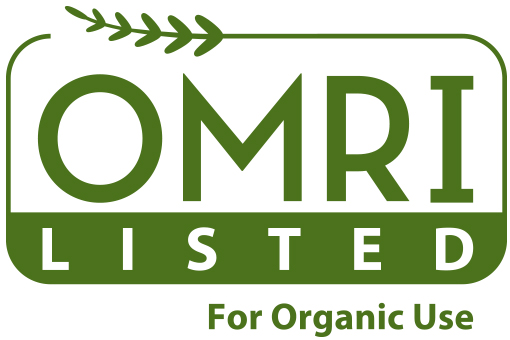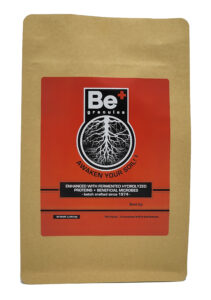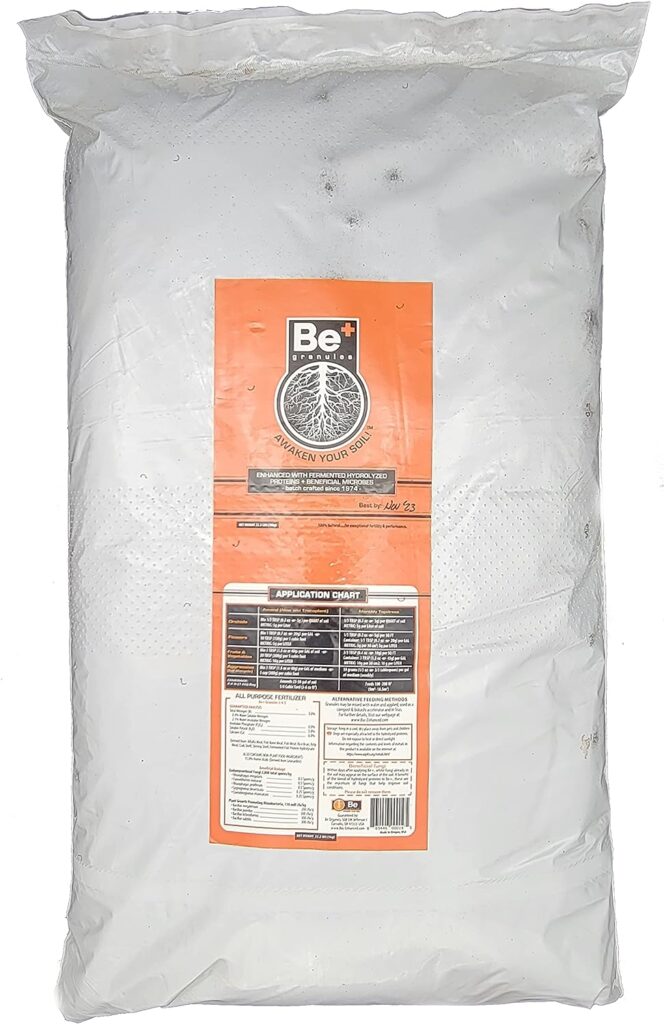FAQs
General FAQ

- Why is it called “Be” and “Be+”?
The name “Be” stands for “Bio-Enhanced,” i.e., fertilizer and biostimulant, plus (+) beneficial microbes and microbe food (complex carbohydrates) all in one product. Ultimate credit also goes to our development team, who spent a little too much time in the lab for our uninspired name. We are not a team of high-powered marketers. Instead, we place our focus on the contents of the bag. - What is the OMRI Listed logo?
OMRI is internationally-recognized among the strictest certification authorities for inputs (fertilizers, pesticides, additives, etc.) used in organic products and is the first ISO 17065 organization accredited by the USDA. Inputs must be approved prior to use on a certified organic operation.
Our Be+ Granules were OMRI reviewed and approved for use under the USDA National Organic Program (NOP), i.e. use OMRI-listed inputs such as Be+ and it will expedite the process for including the USDA “Organic” label on your product. - Do you have any other products?
Nearly all manufactures roll out a lineup of many products to deal with different phases of plant lifecycle and seemingly every purpose. How the heck is the average person supposed to determine what they need?!
We try to simplify by including as much as possible that your soil and plants need in a single product…not a silver bullet, but should be 95% of what you need for microbial, soil and plant health. We are continually pushing the envelope, leveraging the latest research, especially with regards to nutrients and new microbes (esp. endophytes), so while we will not necessarily release new products, we always looking to improve existing ingredients. However, it takes time to run trials.
Meantime, if you make compost teas, check out our teabags. Our medical-grade mesh looks like others, but lets the sticky spores through, while keeping out larger particles. - Is Be+ certified organic in California?
We submitted our application in January 2023. There is apparently a 12-month backlog for organic input materials (OIM) in California. Hopefully, won’t take that long, so stay tuned. - Can I add Be+ with other products?
Yes, is complementary with many other products. Just be sure to ask yourself, “If I add this, how will it impact my microbes?” You will likely be able to use less of those other products.
Although Be+ has an NPK of 3-6-5 for both vegetative and flowering stages, making it a great base, it is not a silver bullet and some plants may require more of some nutrients. Just be sure whatever you add is organic. - Are the Be+ Granules no longer good after the “Best By” date?
Heck yes they are still good! Please use even after the Best Buy date.
Microbial populations listed on the label are what we would expect to see after one year after packaging. So immediately after packaging, then you could expect double the populations.
We typically see a 50% drop in microbial populations each year so just a little less potent after the Best Buy date. - When are you coming to my country/state?
Apparently, much more quickly than anticipated. Demand has exceeded expectations, so we are scaling up. Just look at some of those beautiful Be+ fed plants around on the internet and you’ll understand the reason why. So, check back often. Until we do get to your closest store, please find us on Amazon.
er information, please send us an email.
info@Bio-Enhanced.com - After adding Be+, my tea is foaming like crazy. How do I reduce the foam?
Generally, foam is a good thing. It is the result of microorganisms interacting with the amino acids and breaking down organic matter. Please do not remove the foam. Just try to contain and stir it back into the brew.
Caveat…too much foam may be an indication of too much simple carbohydrates, etc. Try cutting back on the simple sugars, e.g. molasses. - I tried Be+, instead of my conventional fertilizer, but did not really see any change in my crops.
That is great news! That means you went from using a conventional (unsustainable) salt-based fertilizer, to using an organic fertilizer and with no noticeable difference.
Perhaps more important than the visual. How did it taste? Admittedly, organic does not always make the best plastic-looking fruits or vegetables, but you can often taste the difference. When you switch to organic, you will often find an enhanced natural taste. At the same time, when you eat products grown with Be+, you will often note an absence of a sourness, originating from Nitric Acid (HNO3), which is commonly used in conventional fertilizers, as well as explosives!
You may also notice that your edibles are crispier and may even have slightly longer shelf-life. - Do Be+ Granules really feed everything?
Yes, all vascular plants can benefit from more microbes. The main benefit of the amino acids is increasing microbes that transform nutrients into a plant absorbable form. The amino acids also act as a chelating and complexing agent, i.e. amino acids attach to nutrients, resulting in nutrients being more efficiently absorbed by roots.
The combination of increased microbes and more efficient absorption will help provide what the plant needs and nutrients in the granules are typically sufficient. However, the granules alone may not not always enough. In such cases, you can further amend with other organic nutrients or organic matter, e.g. compost. We sometimes add micro-nutrients or trace minerals from seaweed, kelp or rock dust, just to give a bit more mineral variety than the granules contain. Therefore, think of the Be+ as an all purpose base, then you can add other nutrients, if necessary.
AMINO ACIDS
- What amino acids are included?
Are you sure you are not our competitor?
39 years of development and advances from two world-leading amino acid research labs is not easily disclosed. That said…write to us directly and we can discuss.
Most amino acids products on the market today are derived from soybean and most imported from China. However, roughly 90% of U.S. soybean crops are genetically engineered to resist Roundup and contain glyphosate residues. Rest-assured, amino acids in Be+ Granules are fermented from fish and not derived from soybean. - What is the difference between Amino Acids and Proteins?
Congratulations if you made it to this last question. Your understanding is advanced.
Amino Acids are the elemental form of peptides, which are short strings of amino acids. Even longer strings of peptides become proteins. However, before microbes and plants can use proteins, microbes must first break them down into constituent amino acids. We achieve this through fermentation. So if you have the right microbes and can wait a bit longer, proteins will work too. It’s just that amino acids we include are already broken down and immediately available to benefit your microbes/plants.
BENEFICIAL MICROBES
- What micro-organisms are included?
Endomycorrhlzal Fungi:
Rhizophagus irregularis, Funneliformis mosseae, Rhirophagus proliferum, Septoglomus deserticola, Claroideoglomus etunicatum, Claroideoglomus claroideum
Rhizobacteria:
Bacillus megaterium, Bacillus licheniformis, Bacillus subtilis, Bacillus altitudinis
You will also find a white decayer species of marine-origin fungi that is a cousin of the same saprophyte thermophile fungi in your compost pile, so while not a symbiotic microbe, it is beneficial in that it helps break down organic matter and make nutrients plant-available. This fungi originates from the crab and shrimp shell in Be+. The fungi looks like a mold on the surface of the soil but is actually a mat of mycelium from the saprophyte. Please do not remove! - Your granules appear geared towards aerobic microbes and AACT compost teas. What about anaerobic microbes, Bokashi, fermentation and teas?
Ask yourself, “where do plants grow?” Do you see plants growing in anaerobic environments such as clay or water with no circulation? There is a reason for this…plants like/need aerobic environments, i.e., aerobic microbes!
While we do use anaerobic microbes (lactobacillus) for fermenting our nutrients, we do focus on aerobic microbes for plant, microbe and soil health.
GROWING
- I grow only “natives” and just using compost seems fine.
Super cool. Natives are the best way to minimize inputs and conserve water use. However, all plants can benefit from an extra boost, and they can still benefit from our microbes at least once to start a colony, especially at planting and transplanting. Better yet, use our Be+ to inoculate your compost pile! - Does it work on Cannabis?
Yes. And exceptionally well! - I am an experienced master gardener and compost all the time. I really doubt I need your granules. So why should I buy your product?
Indeed, results may be a bit harder to see, but visuals are just one metric…with our amino acids, you will be able to tell a difference in enhanced natural taste and scent, compared to compost alone and you should also still see a discernible difference in plant vigor, foliage thickness and brilliant contrast of colors. Do not forget, the prime directive of Be+ is to increase microbes, so you will also notice your compost pile about is 5°F~10°F hotter, the effect of increased microbial activity. The implication of hotter compost is faster decay of organic matter, from several weeks to months. Who doesn’t need that?
APPLICATION
- Can I add Be+ with other products?
Yes, you can add many other products. Although Be+ has an NPK of 3-6-5 for both vegetative and flowering stages, making it a great base, but may not be a silver bullet, as some plants may require more of some nutrients. Just be sure whatever you add is microbe-friendly, i.e. organic.
OTHER
- Why is it so expensive?
Two reasons: 1) There are no ingredients from China. 2) We have literally put the best ingredients available no matter where from, but fortunate that 90%+ are found in the Pacific Northwest. We stand by each ingredient and guarantee your satisfaction. - I have peanut / seashell fish allergies. Can I still use Be+?
The Be+ does contain peanut meal, crab and shrimp shell. They are a part of the input medium to grow plants, so we have never seen allergic reactions from foods grown with Be+. However, if your allergies are severe, then you may want to take some care in handling Be+ directly. Please read the label for a complete list of ingredients. - Vegetarians and Vegans
Be+ granules are made with shrimp and crab shell as well as fish meal that would have otherwise been thrown out. Therefore, depending upon your particular sensitivity, Be+ is probably fine for most vegetarians, but not for vegans. - My dog ate my Be+!
Please be aware that the amino acids in Be+ attracts pets. Be+ should be kept out of reach of pets. Still, however, numerous inquiries have asked, “what should be done after a pet eats the granules?” Should your pet accidentally digest the granules, watch your pet carefully and, if you notice any issues, immediately take your pet to the veterinarian. To date, fortunately, no pet has been reported as becoming sick from eating Be+. In fact, some sick pets actually got better from eating it, but please do not take the risk. - I tried Be+, instead of my conventional fertilizer, but did not really see any change in my crops.
That is great news! That means you went from using a conventional (unsustainable) salt-based fertilizer, to using an organic fertilizer with no noticeable difference.
Perhaps just as important as the visual. How did it taste? Admittedly, organic does not always make the best plastic-looking fruits or vegetables, but you can often taste the difference. When you switch to organic, you will often find an enhanced natural taste. At the same time, when you eat products grown with Be+, you will often note an absence of a sourness, originating from Nitric Acid (HNO3), which is commonly used in conventional fertilizers, as well as explosives!
You may also notice that your edibles are crispier and may even have slightly longer shelf-life. - What about Bioremediation and Mycoremediation applications?
Bio-remediation is a growing field and we certainly expect to be a player. We are currently working with researchers on using Be+ to grow fungi for use in 1) biodegrading plastics, 2) turning biomass into bio-ethanol/biodiesel and 3) as as a nutrient-substrate for growing fungi that produce unique enzymes and may one day be the next penicillin. Early indications are promising. For further information, please send us an email: info@Bio-Enhanced.com - We want to resell Be+ in our shop. How?
We are growing and happy to add more shops to the Be Organics team. Send us an email. info@Bio-Enhanced.com
As for distributors, we prefer to be as close to our stores and customers as possible, and prefer to remain self-distributed, but thanks! We want to sell Be+ in our shop, but How?
We are growing and happy to add more shops to the Be Organics team. Send us an email. info@Bio-Enhanced.com
As for distributors, we prefer to be as close to our stores and customers as possible, and prefer to remain self-distributed, but thanks! - When are you coming to my country/state?
Apparently, much more quickly than anticipated. Demand has exceeded expectations, so we are scaling up. Just look at some of those beautiful Be+ fed plants around on the internet and you’ll understand the reason why. So, check back often. Until we do get to your closest store, please find us on Amazon.

